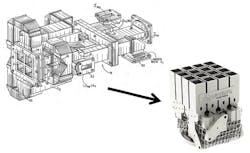3D metal AM allows 100-to-1 parts reduction for satellite maker OptiSys
Optisys (West Jordan, UT), a provider of 3D-printed metal micro-antenna products for aerospace and defense applications, recently completed a project that documents the advantages of using additive manufacturing (AM). The test-piece demonstrator project involved a complete redesign of a high-bandwidth, directional tracking antenna array for aircraft (known as a Ka-band 4x4 Monopulse Array). Optisys performed every aspect of the design work in-house and printed the component in a single piece on their Concept Laser (Grapevine, TX) machine.
RELATED ARTICLE: Trumpf and Siemens partner on software that streamlines metal additive manufacturing
The complex radio frequency (RF) components that make up an antenna system can be large and heavy--characteristics that can impact mobility and performance. "Companies in the commercial and military space are pressured for shorter lead-times, lighter weight and smaller antennas," says Clinton Cathey, Optisys CEO. "By combining RF design simulation, mechanical engineering, and system optimization focused on AM, we provide metal 3D-printed antenna products at greatly reduced size, weight, lead-times, part count and cost--with as-good or better RF performance than conventionally manufactured systems. We're creating structures that were simply not possible to produce in the past."
"Concept Laser's powder-bed fusion in particular is perfect for this application because of the fine resolution it provides for antennas functioning in the one to one-hundred Gigahertz [GHz] range of RF in which most of our potential customers operate," says Cathey. Manufacturing antenna systems via conventional methods such as brazing and plunge EDM is a complex, multistage process that can take an average of eight months of development time and three to six more of build time, says Optisys COO Robert Smith, M.E.
"Our unique offering is that we redesign everything from an additive manufacturing perspective," says Smith. "We take into account the entire system functionality, combine many parts into one, and reduce both development and manufacturing lead times to just a few weeks. The result is radically improved size and weight at lower costs." The project reduced 100 discrete pieces to a one-piece integrated assembly, enabled a 95% weight savings, reduced lead time from 11 to 2 months, reduced production costs 20-25%, and reduced non-recurring costs by 75%.
Optisys can print in a variety of metals with its Concept Laser machine, though for antenna products they prefer aluminum because of its surface conductivity, light weight, corrosion resistance and strength under shock and vibration. "3D-printed metal will have virtually the same properties as a solid piece of the same material for RF performance," says Smith. "Structurally the products have been tested in rigorous vibration environments and they also have the same coefficient of thermal expansion (CTE) as wrought metals. This also gives them better stability over temperature than plastic RF components."
Part consolidation through AM provides a number of downstream benefits as well, Smith says. "Reducing part count also reduces assembly and rework. It's easy to add features to an existing AM design, easier to assemble the finished components and, long-term, you have less testing, maintenance and service when you have fewer parts."
SOURCE: Concept Laser; http://www.conceptlaserinc.com/one-hundred-parts-one/

Gail Overton | Senior Editor (2004-2020)
Gail has more than 30 years of engineering, marketing, product management, and editorial experience in the photonics and optical communications industry. Before joining the staff at Laser Focus World in 2004, she held many product management and product marketing roles in the fiber-optics industry, most notably at Hughes (El Segundo, CA), GTE Labs (Waltham, MA), Corning (Corning, NY), Photon Kinetics (Beaverton, OR), and Newport Corporation (Irvine, CA). During her marketing career, Gail published articles in WDM Solutions and Sensors magazine and traveled internationally to conduct product and sales training. Gail received her BS degree in physics, with an emphasis in optics, from San Diego State University in San Diego, CA in May 1986.
